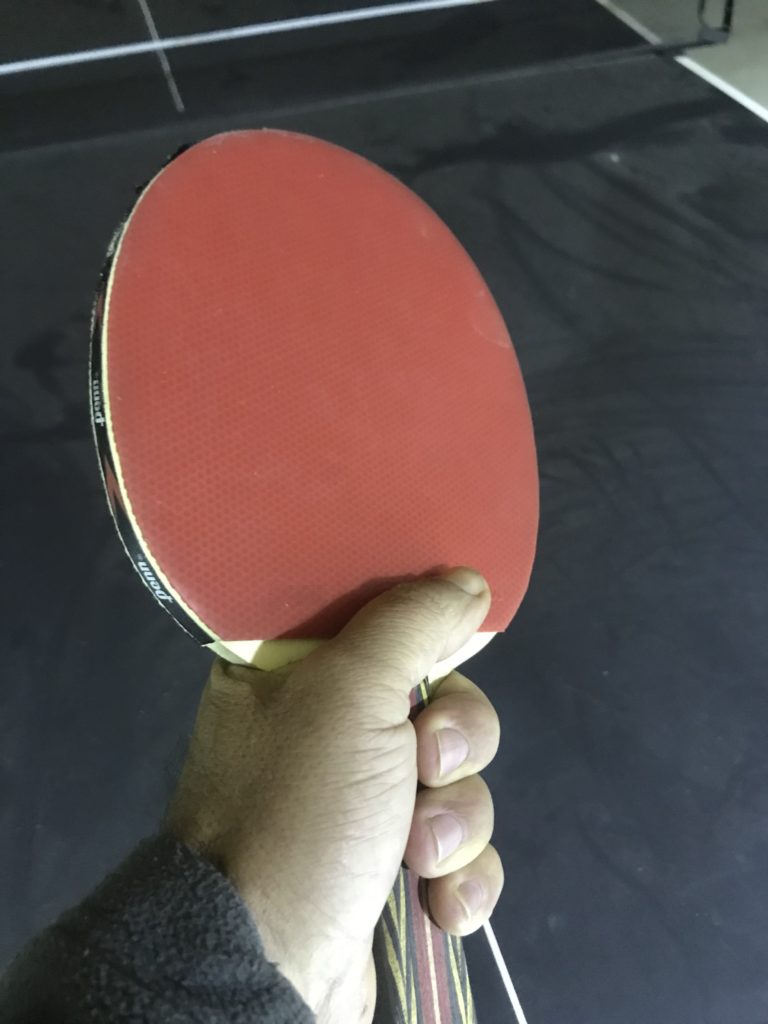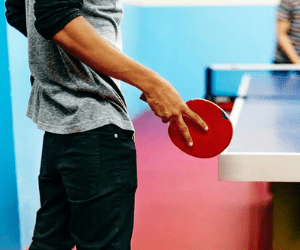I grew up playing ping pong against my father and brothers and we all grip the paddle the same. However, my son uses different grips, I’m not sure where he picked up his style, but he plays pretty well. Which made me wonder about various table tennis grips and how they affect a person’s play.
There are three primary table tennis grips, shakehand, penholder, and seemiller. I’ve seen players use all three and play successfully with each. The effectiveness of your paddle grip primarily depends on what you are comfortable with and how you were taught to play.
Many people believe the penholder grip is the best way to hold a ping pong paddle because it’s the preferred style of Asian players. But there are some great players that use the shakehand style.

Contents
Basics of table tennis
Table tennis is a game played by two or four people. It’s typically played indoors. The players stand at each end of the table, which has a low net across the middle, and hit a small hollow plastic ball over the net by the use of wooden paddles. A table tennis grip is a way a player holds their paddle.
- The ball must be in an open palm before the service starts.
- The ball must be vertically thrown for at least 16cm.
- The ball must be above and behind the table throughout the server.
- After the ball is thrown, the server must get their free arm in and out of the way.
How a correct table tennis grip looks like.
- Your index finger should be on the backhand rubber.
- Your thumb should be tucked in on the forehand sign.
- The other three fingers should loosely be wrapped around the handle
- The V of your hand should be in line with the paddle’s edge Points to consider for a good grip.
- Feel comfortable and confident about your grip.
- Avoid changing grip during rallies.
- Keep an excellent soft, loose grip on the handle of the paddle.

Types of table tennis grip
1. The Shakehand Grip
It’s called a shakehand grip simply because the blade rests on the V shape created by the thumb and the index finger while saving by the other three fingers.
Forms of shakehand grips
- Shallow shakehand grip -the thumb rests on the blade.
- Deep shakehand grip- the thumb rests on the rubber.
Advantages of the shallow shake hand grip
- Since the grip is loose. It allows quicker readjustment of the paddle’s angle.
- Allows one to move his or her wrist freely, and this gives the player a strong power when brushing the ball.
Advantages of deep shakehand grip
- Prevents too much moving of the paddle in the hands of the player.
- Easier movement on either the forehand or backhand strokes.
2. Penhold grip
The paddle handle is gripped the same way one grips a pen when writing with the thumb and index finger in the front while the remaining three fingers slightly curled around the back of the racket for support.
Penhold grip types
- Traditional Chinese grip is whereby a racket is held with the blade facing the ground.
- Japanese or Korean grip is whereby the fingers on the back of the paddle are straightened rather than curled.
- Reverse penhold backhand grip is whereby the back of the penhold paddle is used to hit the backhand.
Advantages
- It allows free movement of the wrist leading to excellent forehead strokes. You often use a lot of space when playing to get into the proper position for slams.
Disadvantages
- It makes it impossible for the penhold grip players to reach either side of the table flexibly, thus forcing penhold style attacking to cover the table with all forehead attacks, and this drains the player’s stamina faster.
3. Seemiller
This type of grip whereby one is required to place the thumb and index finger on either side of the racquet while the rest of the fingers are placed at the bottom part.
Advantages
- Free wrist movement allowing sturdy snaps for forehead topspins.
- Useful for blocking forehead or backhand sides.
Disadvantages
- Backhand side movement is hindered hence limiting powerful returns for the player.
What is wrong with having a backhand or a forehead grip?
Having a backhand grip gives somebody the ability to have lots of controls since the thumb is on the bat, but one would still struggle to play a solid forehand because they will have to drop their wrist slightly.
Some people may decide to switch between the two which gives giving themselves the best of both but it’s difficult to make a quick transition. This works only at a level when one has time to change the grip and anticipate the ball.
It’s not applicable at higher levels because there isn’t time to worry about changing grip in the middle of rallies that turns one into a weak player.
If someone is a novice ping pong player, the first thing they need to decide is the grip they are going to use and then stick with it. If someone is a non-beginner and realizes that his or her grip is not perfect, then they should consider spending enough time to correct that.
It’s worth spending a bit of your time checking your grip to ensure that it does not give you any serious problems.
